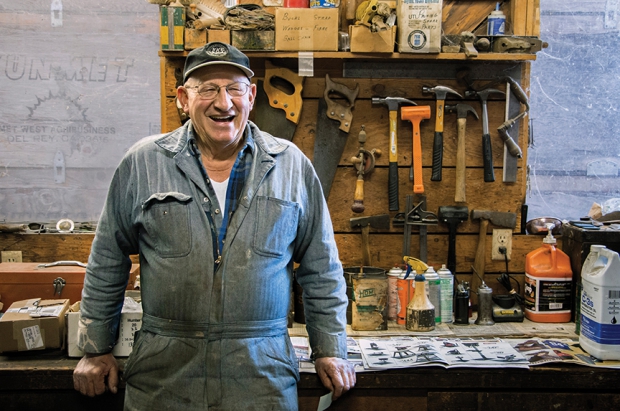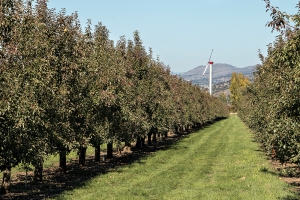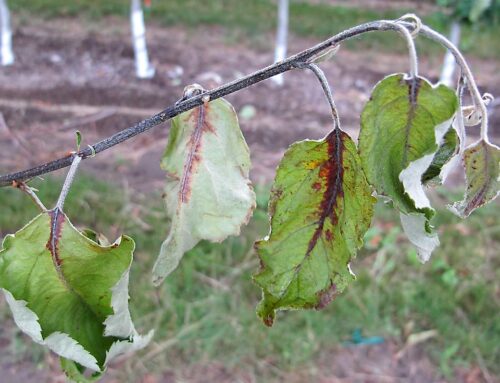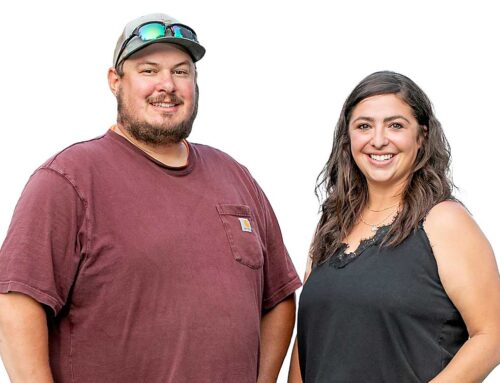
Ron Meyer’s family, of Talent, Oregon, has raised pears for more than 100 years. In addition to 100 acres of pears, he also grows 15 acres of peaches, which he sells in local markets. (TJ Mullinax/Good Fruit Grower)
If he were 30 years younger, Ron Meyer would be putting in new equipment to pack his pears and peaches. Instead, at 75 years, he’s thinking about selling his orchards and liquidating his tree fruit business.
Meyer is hopeful one of his four children will have a change of heart and decide to come back to the family farm. And there’s a chance. Son Kurt, a construction contractor, returned to the farm when the building industry flattened during the recent recession and has been working with Meyer for several years. But his son hasn’t made up his mind about farming long-term and is concerned about the financial aspects of pears and the future of Medford’s tree fruit industry.
“With farming, you just have to accept that there’s no guarantees.”
—Ron Meyer
Ron Meyer is the third generation of his family to grow pears in Oregon’s Rogue River Valley in Talent, a town near Medford. The Meyer family has raised pears for more than 100 years; the first pear orchard was planted in 1910.
Until 2000, Meyer packed his 100-plus acres of pears and eight acres of peaches on his own line. He installed the first Linx electronic weight sizer in the Rogue Valley, technology that later allowed him to affix labels to the fruit. “The transition from the old dimension sizers to electronic technology was a turning point for a lot of growers,” he said. Up to that point, many growers packed their own fruit. “But when new technologies were needed for sizing and stickering, a lot of growers didn’t want to make such a significant investment, and they got out of packing.”
Through the years, he’s cultivated his own markets for pears, including a niche pear variety developed by Oregon State University called BestEver. He has also developed a strong local following for his peaches.

The open-center pear trees in Meyer’s orchard produce from 15 to 18 tons per acre. His production increased when he changed from a cultivated center to a grass orchard floor. (TJ Mullinax/Good Fruit Grower)
“My pears go all over, but my best market is New York,” he said, adding that he learned early in his tree fruit career while working for produce wholesaler Pacific Fruit Produce that if you’re going to be successful in produce, you’ve got to market your product to those who don’t grow it.
He also learned about the finicky nature of local markets during his years at the produce company. “Local markets are very delicate. Once they are overloaded, you can be priced out of business and you have disaster,” Meyer said. He keeps his peaches local because he can’t compete with peaches produced in California.
These days, he sends his fruit to Medford’s major pear packer, Naumes, Inc. He still markets his own fruit, as well as fruit of a few other growers. Naumes packs his fruit and loads out some for railcar shipment.
Pampered trees
Meyer calls his pear trees “my pampered darlings.” His orchard is uniform and very productive, averaging 15 to 18 tons per acre. He plants four rows of Comice, four rows of Bartlett, and four rows of red d’Anjou as a way to pollinize each other, and he prefers open-centered trees to central leader. His spacing for the open-centered system is 20 feet between trees, 16 feet between rows.
He doesn’t like the central leader system because the trees don’t have ladder ways. “There’s no place to put the ladder in a central leader system, however, you can plant them closer together.”
Years ago, he transitioned from a clean orchard floor to a grass cover crop in the row middles and a clean tree row strip. “That has proved to be a great combination. With the grass cover, we’ve been outproducing the clean cultivation program and the trees are performing better,” he said, adding he believes the roots are no longer being cut by the cultivator.
Spring frosts are the number-one reason for crop failure in the Rogue Valley, according to Meyer. He installed orchard fans years ago to reduce his reliance on orchard heating systems. “Fans reduced my oil costs by 80 percent, one of the best things I’ve ever done.” He also uses solid-set irrigation sprinklers for frost control on 15 acres when possible.
Frost control
Using irrigation water for frost control is dependent on having appropriate water rights, the right setup, and timing. Often, spring frosts occur before irrigation water deliveries have started.
“In 2010, a year in which we had a heavy frost, in the blocks where I had sprinklers under the tree and fans, I gained two degrees in warmth,” he said. “In the right situations, sprinklers and fans can be very effective.”
“I’d love to see one of my kids carry on with the family orchards,” he said. “But I don’t want to give them overconfidence because I don’t know where it will end.”
In the late 1960s through the 1980s, the pear business was prosperous, but since the 1990s, Meyer said it’s been more a matter of hanging on, although last year was pretty good.
Risk takers
“Year end and year out, we make about 6 percent return on investment, and that’s not enough for the risk that we take.”
He estimated that it takes about $1 million to grow and pack his crop. And his land is paid for, so that million dollars doesn’t include a land payment. “A hailstorm can wipe you out in 15 minutes. But so far, I’ve been lucky and have never lost the entire crop from frost or hail, the two big dangers.”
Meyer said that the rural farm setting was a great place to raise his children and he still holds hope that Kurt or another child will become the fourth generation to raise pears.
“With farming, you just have to accept that there’s no guarantees,” he said. “Unless you have a passion for it, you probably shouldn’t get into it.” •






I was the District Conservationist for the Natural Resources Conservation Service, USDA, between 1980 and 1988. I had the special opportunity to work with the Meyer family on irrigation, erosion and drainage problems associated with their orchard. I believe Ron’s father’s name was Joe and he enjoyed showing me his “Race Car”. Their peach packing operation was one of the first and produced very high quality fresh peaches. The Meyer’s were always driven to accept only high quality fruit from their operation and required high quality management, which they always practiced. I wish Ron the best in his “retirement”. If he desires to answer this question OK — “What was the dish called, that you cooked inside the grape leaves?”
We really enjoy getting Pears, all three kinds, from Ron Meyer. Look forward to his Pears each year.
and hope to try their Peachs. Pat Jackson
I would sure hate to see your orchard go Ron, hopefully Kurt will take over. I still remember the days I would visit with your father Joe Myers out in the orchard when I was in charge of the Green Hills orchard next to yours. I fear some day most of the orchards in our valley will be gone. You take care and have a good future, A friend — Eugene Downes (Ex-Bear Creek Foreman)